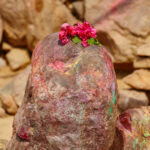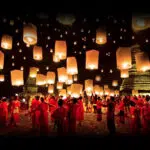Georgia O’Keeffe, born on November 15, 1887, made a significant contribution to the growth of modern art in America by becoming the first respected female painter in New York in the 1920s. Her vibrant and dramatic paintings of flowers and New York skyscrapers are particularly well-known. She was referred to as a pioneer because of her innovative and distinctive style of painting nature by emphasizing its basic shapes and forms. The highest distinction for American civilians, the Presidential Medal of Freedom, was given to O’Keeffe by President Gerald Ford. She truly deserves a grand birthday celebration from us.
Fast Facts
Full Name:
Georgia Totto O'Keeffe
Birth date:
November 15, 1887
Death date:
March 06, 1986
Age:
98 years, 3 months
Zodiac Sign:
Scorpio
Net Worth:
$1.5 million
Background
Georgia O’Keeffe was born in a farmhouse in the town of Sun Prairie, Wisconsin on November 15, 1887, to Francis and Ida. Her mother had Dutch and Hungarian ancestry, while her father was Irish. Her parents had a dairy farm and she was the second of seven children. Her parents arranged for her to take lessons from a local artist because she had a passion for art from a young age. She graduated from Virginia’s Chatham Episcopal Institute in 1905. She belonged to the Kappa Delta sorority. From 1905 to 1906, she attended the School of the Art Institute of Chicago before transferring to the Art Students League in New York City. She was given a scholarship to attend The League’s outdoor summer school in Lake George, New York, where she studied under William Merritt Chase.After enrolling in a course at the University of Virginia Summer School, O’Keeffe began painting in 1912. There, she discovered Arthur Wesley Dow’s ground-breaking concepts. She then taught art in the public schools in Amarillo, Texas, for the following two years. She enrolled in Teachers College at Columbia University in 1914 and began taking classes with Dow, who would have a significant impact on O’Keeffe’s paintings. She continued to teach while beginning to produce her own art in 1915, finishing a series of highly innovative charcoal abstractions. Some of her abstract drawings were delivered to a friend in New York City, who then showed Alfred Stieglitz, a well-known art dealer and renowned photographer, the artwork. The sketches were also very well received by Stieglitz, who displayed 10 of them in 1916 at his gallery, 291. The next year, he produced O’Keeffe’s first solo exhibition at 291, which featured watercolors and oil paintings created in Texas. By 1918, he had persuaded O’Keeffe to go to New York so that she could focus solely on her artwork.During the 1920s, she produced several important works, such as “Petunia, No. 2 (1924),” “City Night and New York—Night (1926),” and “Radiator Bldg—Night, New York (1927).” She had established herself as one of the most significant American artists by the middle of the 1920s. When she visited New Mexico for the first time in 1929, she was profoundly touched by the landscape, artistic expression, and architectural design of the state. Between 1929 and 1949, she made yearly trips to New Mexico to paint churches, structures, and other interesting artifacts before relocating there permanently. Throughout the 1930s and 1940s, her reputation as an artist grew, and her works were displayed in several shows in and around New York. In the 1940s, she had two solo exhibitions, the first in 1943 at the Art Institute of Chicago and the second in 1946 at the Museum of Modern Art (M.O.M.A.) in Manhattan. One of O’Keeffe’s most well-known paintings, “Summer Days,” depicts a deer’s skull covered in colorful wildflowers on a background of a desert. She also has a popular artwork called “Ram’s Head, Blue Morning Glory,” which shows a ram’s skull and a blue morning glory side by side.O’Keeffe initially met Alfred Stieglitz, a well-known photographer and gallery owner, in 1908; but, they didn’t start communicating until a few years later, in the middle of the 1910s. Even though Stieglitz was married and 23 years her senior, they started dating. In 1924, Stieglitz wed O’Keeffe after divorcing his first spouse. On March 6, 1986, she passed away at the age of 98.
Career timeline
She begins producing her own original artwork, using highly innovative charcoal abstractions.
A well-known art dealer and renowned photographer named Alfred Stieglitz organizes O'Keeffe's first solo exhibition at 291, which comprises oil paintings and watercolors created in Texas.
O'Keeffe begins to create abstract paintings, including "Red & Orange Streak / Streak," which is among her most inventive and thought-provoking pieces.
She visits New Mexico and begins painting churches, buildings, and other interesting things there after being deeply moved by the landscape, art, and architectural style of the state.
Her paintings are featured in many exhibitions in and around New York, including two one-woman retrospectives, the first of which is held at the Art Institute of Chicago and the second at the Museum of Modern Art (M.O.M.A.) in Manhattan.
She is admitted to the “National Women's Hall of Fame.”
Georgia O'Keeffe FAQs
Why did Georgia O'Keeffe draw flowers?
O’Keeffe’s high school art teacher taught her how to draw flowers. Because of the significant influence this teacher had on her, she later turned to flowers when she was feeling down and unmotivated in her career. She used flowers to explore and convey feminine sexuality, and the large floral images that fill the canvas imply the vastness of nature and encourage the observer to interpret flowers in new ways.
What was Georgia O Keeffe's first painting?
“Dead Rabbit and Copper Pot (1908)” was O’Keeffe’s first painting.
What is Georgia O Keeffe's largest painting?
The eight by 24-foot “Sky Above Clouds IV,” which now hangs above a grand staircase at the Art Institute of Chicago, was painted by O’Keeffe during the summer of 1965 and is the largest piece of art in her career.
5 Surprising Facts
-
Lifetime Television produced a biopic of her
In 2009, Lifetime Television released an O'Keeffe biopic featuring Joan Allen as the artist.
-
She only created about 200 flower paintings
Although O'Keeffe is most known for her expressive, realistic paintings of flowers, such as Oriental Poppies and Jimson Weed, they only accounted for approximately 200 of her more than 2,000 paintings.
-
25,000 pages of love letters exchanged
O'Keeffe and her spouse Stieglitz exchanged 25,000 pages of love letters.
-
She was honored by the president
President Ronald Reagan presented her with the National Medal of Arts in 1985.
-
The American Academy of Arts and Letters
In 1962, she was chosen for membership in the American Academy of Arts and Letters.
Why We Love Georgia O'Keeffe
-
She was a true artist
O'Keeffe embodied what a true artist is. She was known as a pioneer of art for her unique style of capturing nature in shapes and forms that were both familiar and unique.
-
She was devoted to her work
As long as she could, O'Keeffe continued painting on her own because she was wholly committed to her work. Not even bad weather could keep her away. She continued working even when her eyesight began to deteriorate in her older years. To assist her with painting, she recruited a helper.
-
She was an American icon
She is regarded as one of the most important and captivating painters of the 20th century and is well-known throughout the world for her boldly innovative art. Her distinctive flowers, striking cityscapes, brilliant landscapes, and depictions of bones against a harsh desert sky are renowned and unique contributions to American Modernism, a form of art that dramatically broke from earlier traditions. Her creations serve as a tangible example of modern America.
Georgia O'Keeffe’s birthday dates
| Year | Date | Day |
|---|---|---|
| 2022 | November 15 | Tuesday |
| 2023 | November 15 | Wednesday |
| 2024 | November 15 | Friday |
| 2025 | November 15 | Saturday |
| 2026 | November 15 | Sunday |



















































